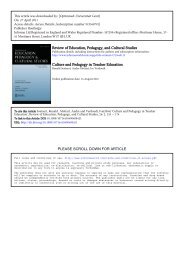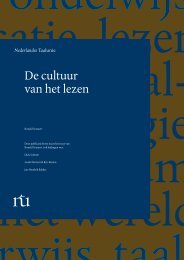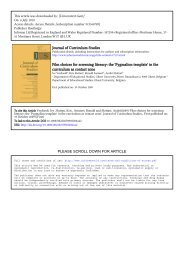a view informed by the problems of traditional literacy in a digital age
a view informed by the problems of traditional literacy in a digital age
a view informed by the problems of traditional literacy in a digital age
You also want an ePaper? Increase the reach of your titles
YUMPU automatically turns print PDFs into web optimized ePapers that Google loves.
Downloaded <strong>by</strong> [University <strong>of</strong> Gent] at 06:46 09 December 2011<br />
Ronald Soetaert & Bart Bonamie<br />
<strong>in</strong>tegrated <strong>in</strong> <strong>the</strong>ir subject and <strong>the</strong>ir area <strong>of</strong> expertise as a tool for organis<strong>in</strong>g<br />
and deliver<strong>in</strong>g course content and <strong>the</strong>ir own pr<strong>of</strong>essional development.<br />
As consumers, <strong>the</strong>y should be critical <strong>of</strong> products and <strong>in</strong>stitutions that<br />
market <strong>the</strong>mselves as legitimate providers <strong>of</strong> education. At <strong>the</strong> same time,<br />
teachers should become producers too; <strong>the</strong>y will be <strong>in</strong>volved <strong>in</strong> develop<strong>in</strong>g<br />
material. This <strong>in</strong> an <strong>in</strong>evitable process; <strong>in</strong> <strong>the</strong> long run textbooks will<br />
change. More and more <strong>the</strong>y will be applied to a grow<strong>in</strong>g variety <strong>of</strong><br />
functions and <strong>the</strong>y will be transformed <strong>in</strong>to <strong>digital</strong> environments.<br />
The shift away from textbooks as <strong>in</strong>k-on-paper products redef<strong>in</strong>es <strong>the</strong><br />
work <strong>of</strong> publishers, authors and … teachers. Design has become a central<br />
issue <strong>in</strong> education. And <strong>in</strong> design educational aspects have become a central<br />
concern.<br />
Conclusion<br />
We need a mean<strong>in</strong>gful vision for culture and education <strong>in</strong> <strong>the</strong>se<br />
transformational years, as we struggle to establish new forms <strong>of</strong> langu<strong>age</strong><br />
and culture with new technologies. Such a vision should be <strong>in</strong>spired <strong>by</strong> <strong>the</strong><br />
recognition that our traditions are forced <strong>in</strong>to a new context. By br<strong>in</strong>g<strong>in</strong>g all<br />
<strong>the</strong>se ‘post’ perspectives toge<strong>the</strong>r and <strong>by</strong> question<strong>in</strong>g or problematis<strong>in</strong>g<br />
<strong>the</strong>m, we hope that we have illustrated how <strong>the</strong> <strong>digital</strong> revolution has deeply<br />
<strong>in</strong>fluenced <strong>the</strong> subjects that we are teach<strong>in</strong>g, and <strong>the</strong> roles that teachers can<br />
play <strong>in</strong> new teach<strong>in</strong>g and learn<strong>in</strong>g environments.<br />
A cultural perspective on this paradigm shift seems essential, <strong>in</strong>spired<br />
<strong>by</strong> cultural studies, media studies and discourse analysis. In <strong>the</strong>se<br />
discipl<strong>in</strong>es, <strong>the</strong> concept <strong>of</strong> <strong>literacy</strong> is deconstructed to an extent that we are<br />
now <strong>in</strong>vited to construct new educational practice. We suggest that all<br />
teachers – and langu<strong>age</strong> teachers <strong>in</strong> particular – should reflect on <strong>the</strong> ways<br />
<strong>in</strong> which tools change our cultural space. With<strong>in</strong> this approach, <strong>the</strong>re would<br />
be a need to develop a critical sense <strong>of</strong> <strong>the</strong> form <strong>of</strong> ‘media <strong>literacy</strong>’<br />
(O’Sullivan, 1999). This would educate learners to resist <strong>the</strong> surface<br />
mess<strong>age</strong>s from today’s new media. It would also enable <strong>the</strong>m to be able to<br />
use all types <strong>of</strong> media effectively <strong>the</strong>mselves <strong>in</strong> a variety <strong>of</strong> cultural contexts,<br />
<strong>in</strong>clud<strong>in</strong>g contexts <strong>of</strong> <strong>the</strong>ir own mak<strong>in</strong>g.<br />
Our approach to langu<strong>age</strong> teach<strong>in</strong>g today is <strong>in</strong>spired <strong>by</strong> a s<strong>in</strong>gle<br />
question: are we only go<strong>in</strong>g to use <strong>the</strong> Internet to teach culture <strong>in</strong> a<br />
<strong>traditional</strong> way, or can we capitalise on its potential to give students access<br />
to new k<strong>in</strong>ds <strong>of</strong> culture(s)?<br />
Acknowledgements<br />
The Langu<strong>age</strong> Teach<strong>in</strong>g On-L<strong>in</strong>e project was supported <strong>by</strong> DG_XII <strong>of</strong> <strong>the</strong><br />
European Commission.<br />
This article has been edited <strong>by</strong> <strong>the</strong> General Editor with permission<br />
from <strong>the</strong> authors.<br />
144





